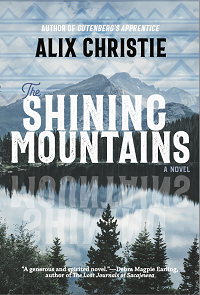Our Multicultural Family History
Alix Christie
From an early age I was fascinated by the stories my Canadian grandmother told of her Scottish forbears in the Pacific Northwest, particularly one 19th century fur trader, Archibald McDonald, who married an alleged “princess” of the Chinook tribe. Decades later I would understand how offensive this fantasy depiction of Native wives of white men could be, and how common it unfortunately was. Yet as a child I was enraptured enough to draw a detailed family tree, showing that Archibald had indeed married Raven, a daughter of Chief Comcomly of the Chinook tribe. There the matter would have rested, if my younger brother, a historian and professor of literature, hadn’t turned up one day a decade ago with a boxful of books. He’d just written a scholarly paper on another distant relative, Duncan McDonald, and was gifting me his research. “For your next novel,” he said.
A quick count of the “Cast of Characters” of the book that eventually resulted adds up to more than fifty names. They include those Scots Highlanders, French missionaries, British bosses, American trappers, Norwegian, German and English immigrants, and Native Americans from five different tribes across the Rocky Mountain West. Though my research began with that one man — Duncan McDonald, son of our Scots great-great-great-uncle Angus and his Nez Perce wife Catherine—the story I discovered reached back several generations and across a vast expanse of the West, from the Rocky Mountains to the Pacific Ocean. It all came together when I flew to Montana to meet my many cousins on the Flathead Reservation, all enrolled tribal members descended from Angus and Catherine.
 |
| Angus McDonald, 1860s, at the new international boundary between the U.S. and Canada |
 |
| Catherine McDonald (Kitalah—Eagle Rising Up, Nez Perce), studio portrait, 1860s Montana |
The Shining Mountains recounts the life and times of this mixed-race family—half Scots Highlander, half Nez Perce, Mohawk and French—who were prominent in the last years of the fur trade between 1840 and 1860 in Washington, Oregon, Idaho and Montana. Angus McDonald was the last Chief Trader for the Hudson’s Bay Company in the vast chunk of territory that would become the northwestern United States. But it wasn’t his prominence that most amazed me. What struck me with even greater force was how incredibly multicultural was the mid-19th century world within which he and his family moved. We Americans have traditionally called our country a “melting pot” but on its western edge it was less melted than bubbling with many diverse peoples, all intermarrying and hunting and farming and trading together, Norwegian and Salish and Scottish and Yakama, French and Russian and yes—American. It was a Babel as well: many Native tribes communicated with one another through sign language, while the traders who bought furs from them used a pidgin they called “Chinook-wawa”.
 |
| Two of Angus and Catherine’s children, Angus P. and Maggie McDonald, in full Scottish regalia, 1870s Montana |
 |
|
| Angus and Catherine’s son Duncan McDonald, with his wife Louise “Quil-see” Shumtah (Salish), in Native dress with American flag, 1870s Montana |
 |
| The author with the late Dr. Joe McDonald, Angus & Catherine’s great-grandson, at the family cemetery at Post Creek, Montana (2016) |
When I think now of the history of this country, I think of Joe, and of his cousin Maggie, the head of McDonald Ranch, and the rest of those descendants five and six generations later, every possible blend of indigenous and immigrant. America has always been a multicultural place, a mixing and mingling of different peoples and cultures. It’s a vital thing, today, to keep in mind.
~
The Shining Mountains (High Road Books/University of New Mexico Press) appeared in paperback in early March 2025. Also in e-book, audiobook and hardback wherever books are sold.



